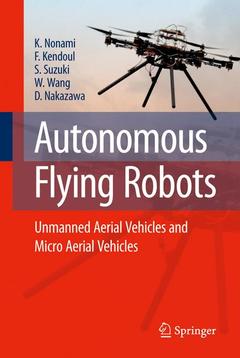Description
Autonomous Flying Robots, 2010
Unmanned Aerial Vehicles and Micro Aerial Vehicles
Authors: Nonami Kenzo, Kendoul Farid, Suzuki Satoshi, Wang Wei, Nakazawa Daisuke
Language: English
Subject for Autonomous Flying Robots:
116.04 €
In Print (Delivery period: 15 days).
Add to cart
Autonomous Flying Robots
Publication date: 11-2014
329 p. · 15.5x23.5 cm · Paperback
Publication date: 11-2014
329 p. · 15.5x23.5 cm · Paperback
158.24 €
In Print (Delivery period: 15 days).
Add to cart
Autonomous flying robots: Unmanned aerial vehicles and micro aerial vehicles
Publication date: 09-2010
329 p. · 15.5x23.5 cm · Hardback
Publication date: 09-2010
329 p. · 15.5x23.5 cm · Hardback
Description
/li>Contents
/li>Comment
/li>
The advance in robotics has boosted the application of autonomous vehicles to perform tedious and risky tasks or to be cost-effective substitutes for their - man counterparts. Based on their working environment, a rough classi cation of the autonomous vehicles would include unmanned aerial vehicles (UAVs), - manned ground vehicles (UGVs), autonomous underwater vehicles (AUVs), and autonomous surface vehicles (ASVs). UAVs, UGVs, AUVs, and ASVs are called UVs (unmanned vehicles) nowadays. In recent decades, the development of - manned autonomous vehicles have been of great interest, and different kinds of autonomous vehicles have been studied and developed all over the world. In part- ular, UAVs have many applications in emergency situations; humans often cannot come close to a dangerous natural disaster such as an earthquake, a ood, an active volcano, or a nuclear disaster. Since the development of the rst UAVs, research efforts have been focused on military applications. Recently, however, demand has arisen for UAVs such as aero-robotsand ying robotsthat can be used in emergency situations and in industrial applications. Among the wide variety of UAVs that have been developed, small-scale HUAVs (helicopter-based UAVs) have the ability to take off and land vertically as well as the ability to cruise in ight, but their most importantcapability is hovering. Hoveringat a point enables us to make more eff- tive observations of a target. Furthermore, small-scale HUAVs offer the advantages of low cost and easy operation.
Modeling and Control of Small and Mini Rotorcraft UAVs.- Fundamental Modeling and Control of Small and Miniature Unmanned Helicopters.- Autonomous Control of a Mini Quadrotor Vehicle Using LQG Controllers.- Development of Autonomous Quad-Tilt-Wing (QTW) Unmanned Aerial Vehicle: Design, Modeling, and Control.- Linearization and Identification of Helicopter Model for Hierarchical Control Design.- Advanced Flight Control Systems for Rotorcraft UAVs and MAVs.- Analysis of the Autorotation Maneuver in Small-Scale Helicopters and Application for Emergency Landing.- Autonomous Acrobatic Flight Based on Feedforward Sequence Control for Small Unmanned Helicopter.- Mathematical Modeling and Nonlinear Control of VTOL Aerial Vehicles.- Formation Flight Control of Multiple Small Autonomous Helicopters Using Predictive Control.- Guidance and Navigation of Short-Range UAVs.- Guidance and Navigation Systems for Small Aerial Robots.- Design and Implementation of Low-Cost Attitude Quaternion Sensor.- Vision-Based Navigation and Visual Servoing of Mini Flying Machines.- Autonomous Indoor Flight and Precise Automated-Landing Using Infrared and Ultrasonic Sensors.
Each chapter contains video links where the readers can actually see the UAVs and MAVs moving. Not only military use but especially civil applications are described in this book. This book is for all those readers who want to gain comprehensive knowledge on unmanned aerial vehicles. Includes supplementary material: sn.pub/extras
© 2024 LAVOISIER S.A.S.
These books may interest you

Unmanned Rotorcraft Systems 147.88 €



